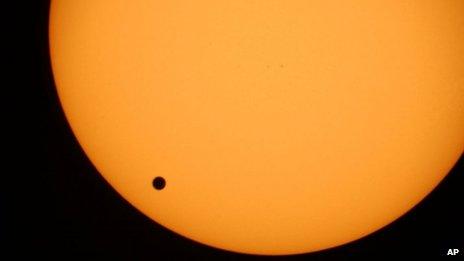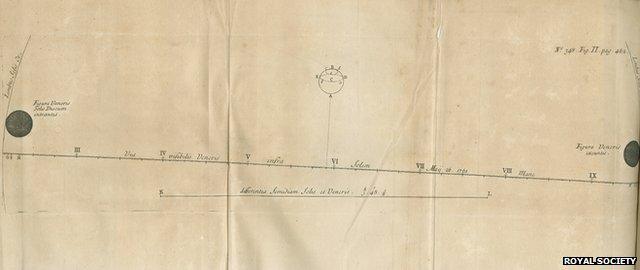The transit of science
- Published
- comments

"This is Philosophical Transactions from 1716, and Halley's paper - which is in Latin - is number five in the volume".
Taking care not to damage the brittle, yellowing pages the Royal Society's chief archivist and librarian Keith Moore turns to one of the seminal scientific papers in both the Society's - and science's - history. Edmund Halley's 1716 essay - A New Method of Determining the Parallax of the Sun.

Figure for the Transit of Venus by Edmond Halley, from Philosophical Transactions of the Royal Society, 1716.
Although Halley wasn't the first to observe a Transit of Venus - when the planet passes in front of the sun - his paper threw down a gauntlet to the then nascent scientific community. A challenge to use the pair of transits predicted to occur in 1761 and 1769 to transform astronomy into a fully fledged empirical science by calculating the distance of the earth to the sun.
It was a call to arms that would launch a thousand ships according to Andrea Wulf, the author of Chasing Venus: The Race to Measure the Heavens. Astronomers from all over the world took up the challenge, organising expeditions and overcoming enormous obstacles to make their observations from the farthest corners of the globe.
"This is a time when clocks are still not precise enough to determine longitude," she says. "A time when a letter from Philadelphia to London takes two or three months to arrive."
"It was clear right from the beginning that it would have to be an international scientific collaboration. Countries which were at war would have to work together. Just the logistics of it must have been absolutely extraordinary."
Halley's idea was to observe and measure the transits from separate points, as far apart as possible, giving a wide base-line from which to use basic trigonometry to calculate the distance between Venus and the earth.
Because astronomers had a good idea about the relative distances between the celestial bodies, it should be possible to use this one empirical measurement to calculate the dimensions of the entire solar system.
"What the observers of the Transit of Venus were after was the fundamental unit of astronomical measurement" according to the Oxford astronomer Dr Chris Lintott.
"Once you get that then the scale of everything else falls into place, and that's why there was this huge effort and enthusiasm to travel to the far ends of the earth to get this one fundamental measurement."
Tom Feilden reports on how the Transit of Venus shaped modern science
From Jean Chappe's gruelling trek across Siberia, to Captain Cook's voyage to Tahiti (and eventual discovery of Australia), the swashbuckling exploits of the transit scientists read like the chapters in a boys-own adventure story.
Charles Mason and Jeremiah Dixon (later to divide America along the Mason-Dixon line) team up for the first time at the Cape of Good Hope, while Guillaume Le Gentil spends 11 years travelling the globe, sees only cloudy skies, and returns home to find his heirs have declared him dead and divided his estate.
But perhaps the most enduring legacy of the transit decade, Andrea Wulf argues, was the model of collaborative international scientific research and exploration it helped to forge.
"The whole idea of a modern scientific expedition is formed in this time. From now on if you go to another place on the globe, its accepted that you have to take a scientific team with you. So we get Charles Darwin on the Beagle, and even Napoleon, when he invades Egypt, takes two hundred scholars with him. It all stems from this single endeavour to measure the size of the solar system."
And transits still form a vital component in the astronomer's arsenal. The Kepler Space Telescope, launched in 2009, uses the tell-tale dip in the luminosity of distant stars to spot extra-solar planets orbiting in front of them. To date it's spotted 61 new worlds, with a further 2321 planet candidates awaiting confirmation.
You can find out more about the events and viewing opportunities for next week's Transit of Venus here,, external and while you're watching that small black dot march across the surface of the sun, spare a thought for the adventurers and explorers who travelled to the farthest corners of the globe to measure the transits of 1761 and 1769.
They put a figure of 93,726,900 miles on the distance from the earth to the sun - less than 800,000 miles off today's calculation - and built a model for international scientific collaboration that endures to this day. An astonishing achievement.
- Published12 March 2012
